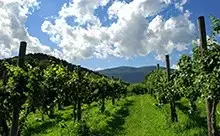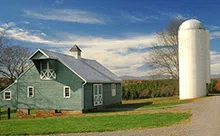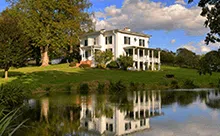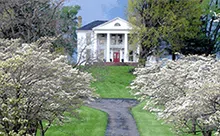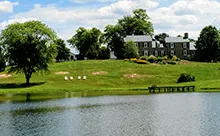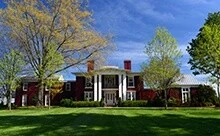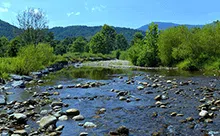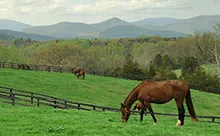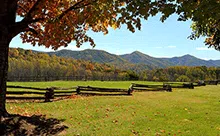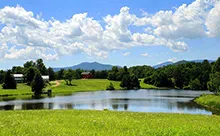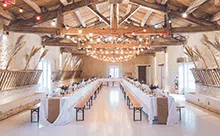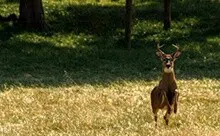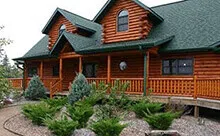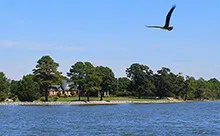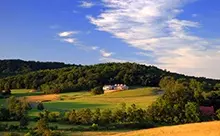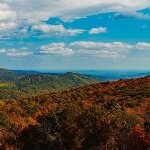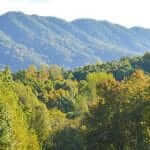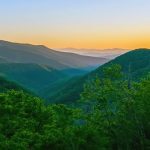Virginia’s Trails Are More Than Just Dirt
Virginia’s Trails Are More Than Just Dirt

There are many well-worn trails in Virginia. When one hears the word trail, their brain most often instinctively conjures up images of dirt and rock surrounded by trees, maybe a stream crossing here or there, and an overlook or vista at the end of your trek. The most famous, the Appalachian Trail, comes to mind. We’ll cover that, and several must-see hiking trails, but there are themed destinations, driving, paddling, and riding trails as well that are less known, often overlooked, but just as exciting and interesting, and you’ll find plenty of trails that are more than just dirt here in Virginia.
African American History in Virginia
African Americans have played a part in Virginia’s history since they first stepped foot on its soil and there are several dozen sites all across the state that honor them and tell their story. You can begin your journey on the Richmond Slave Trail, which educates visitors on the demanding hardships and terrible things slaves were forced to endure. You’ll start the by docks and markets that fueled the slave trade, work your way through several important places in Richmond, and end at First African American Church. Finish your visit with a trip to the Black History Museum and Cultural Center of Virginia, which highlights the culture and history of African Americans in Virginia. If you’re out and about across the state, other African American historical highlights include the Appalachian African-American Cultural Center in Pennington Gap, the Booker T. Washington National Monument and Plantation Trail in Hardy, the Freedom House Museum in Alexandria, or learn about some of the first black aviators at the Virginia Air and Space Center in Hampton. If you’re interested in the Civil Rights movement, the Robert Russa Moton Museum in Farmville was the site of the first non-violent protests which culminated in the Brown vs. Board of Education Supreme Court decision. These places are just a fraction of the locations where you can learn about and walk in the footsteps of Virginia’s African Americans.
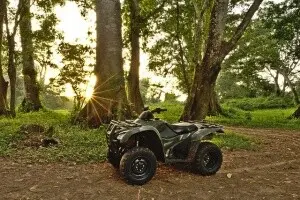
ATV Trails To Boost Your Adrenaline in Virginia
If you have an ATV and are living in or visiting Virginia, you’re in luck. Thanks to the foothills and mountains of the Blue Ridge Mountains and Shenandoah Valley there are trails for the novice and experienced rider alike, offering a combination of varying terrain, great scenery, and picture worthy views. For days of fun from dawn till dusk, head to Virginia’s largest connected trail system, the Spearhead Trails. With over 400 miles of connected trails, including the recent connection to the Hatfield-McCoy trails in West Virginia, it would be easy to spend a weeklong vacation in this location, but there are plenty more to explore. Jefferson National Forest and George Washington National Forest, both, have incredibly remote ATV and OHV trail systems. The South Pedlar ATV Trail System near Big Island is nineteen miles in length and primarily passes through dense woods. Moto Cove Off-roading in Gore is an ATV park with a few dozen trails with rough terrain and challenging obstacles. If you’re brand new to ATV riding, Appalachian Adventures in Luray has guided instructional rides for beginners and ATV rentals available.
Autumn Activities in Virginia
Get lost in a corn maze or get spooked on a haunted trail! Corn mazes are great family-friendly fun for families and groups of all ages and sizes. Coincidentally, many corn mazes are co-located with pumpkin patches. Take a hayride, carry off some pumpkins to carve when you get home, and don’t forget those cute gourds the little ones love. Liberty Mills Farm in Somerset is the largest corn maze in the state of Virginia. Each year, the maze has a different theme with an associated trivia game of hidden questions throughout it. If you’re up for the challenge and can answer each question correctly, you’ll be rewarded. Other corn mazes across Virginia are located Berkeley Plantation in Charles City, Crab Orchard Corn Maze and Pumpkin Patch in Tazewell, Owen Farm in Danville, Skeeter’s Maze in Waynesboro, Temple Hall Farm Regional Park in Leesburg, and Valley Star Farm in Luray.
Would your family and friends say you’re brave? Or would you let out a grimacing scream at the first ghoul you encounter? Virginia has numerous haunted trails full of creatures, ghosts, goblins, monsters, and all things that fill your worst nightmares. Check out The Death Trail in Dumfries, Haunted Hill Trail in Partlow, Scream Forest in Glen Allen, Shadows of Shockoe in Richmond, and Terror Woods in Chesapeake. If the weather isn’t cooperating visit the sights that will make you scream inside, at one of Virginia’s haunted houses. Haunted Nightmares in Winchester, Madam Redrum’s in Waynesboro, Shocktober in Leesburg, Spooky Acres in Portsmouth, St Albans Sanatorium in Radford, and The Warehouse in Weber City are all consistently rated very high. You don’t, however, need to wait until Halloween to trek through a supposedly haunted location. Just east of Buena Vista, the Appalachian Trail crosses Bluff Mountain. Over a century ago, four year-old Ottie Powell got lost in the woods and unfortunately perished in the elements. For decades, hikers have reported sights of Ottie. If you’re up for it, spend the night in Punchbowl Shelter on the AT, which some hikers elect to bypass due to the superstitions surrounding the area. Visitors to Civil War battlefields, where countless soldiers died, have also reported strange occurrences taking place when the sun goes down.
If your inner compass isn’t the greatest or you’re just a little feint of heart when it comes to all things scary, Virginia still has you covered in the fall. Thanks to the varying elevations and weather, leaf-peeping usually begins in early October and lasts through most of November. That’s almost two full months of amber, brilliant yellow, and fiery orange and red. By nature’s design, the leaf-peeping begins at the higher elevations in the southern and western portions of the state. When the trees are bare and brown on Whitetop Mountain, the color is in full swing in Richmond, and the trees are turning in Virginia Beach.
Two of the most popular destinations to view the leaves in Virginia are The Blue Ridge Parkway and Skyline Drive. From both of these there hundreds of miles of accessible trails ranging in length from short, level loops to overnight hikes of dozens of miles with several climbs and descents. The Mountain Trail Farm at the visitors center (MP 5), Wigwam Falls at the Yankee Horse Trail Overlook (MP 34), Abbott Lake Trail at Peaks of Otter Lodge (MP 85), and the Mountain Industry Trail located at the picturesque Mabry Mill (MP 176) are all easy, short walks. For trails a little more moderate in length, try Humpback Rocks Loop (MP 5), Otter Creek and Lake Loop (MP 63), or the Smart View Loop (MP 154). If you’re used to hiking longer distances, St Mary’s Falls (MP 20) and Rock Castle Gorge Loop (MP 169) are both over ten miles in length.
Shenandoah National Park has over 500 miles of trails accessible from Skyline Drive at the top and numerous fire roads and parking areas from the base of the mountains. If you go for the leaves, however, be prepared for company. October is Skyline Drive’s busiest month, and for good reason. Shenandoah National Park is split into three sections and all three offer great choices to see the trees bursting with color for everyone’s different hiking capabilities. In the North District, Fox Hollow Loop (MP 4) and For Windham Rocks (MP (10) are easy hikes that are good for novices and families with children. Little Devils Stairs from the park’s boundary is strenuous, but offers a gorge, rock scramble, and stream crossings. In the Central District there are multiple easy, short hikes. In fact, instead of one longer hike, some visitors enjoy taking a few or several short hikes to afford them the opportunity to see more of Shenandoah National Park. Blackrock Viewpoint, Stony Man Trail, and Story of the Forest Trail are all within a half-hour drive of one another. The Limberlost Trail is a favorite with kids and is even ADA accessible. Dark Hollow Falls, Old Rag, Upper Hawksbill, and White Oak Canyon are the most frequented moderate to strenuous trails. The Southern District has Blackrock Summit as an easy Track Trail For Kids, which offers stunning 360 panoramas. Who doesn’t love a waterfall surrounded by vivid colors? Try Doyles River and Jones River Falls trails. Don’t forget to check out the Shenandoah National Park webpage by the National Park Service for almost endless possibilities. If you’ve hiked it once in the summer, it’s a completely different environment in the fall.
Virginia has city, county, private, and state parks and nature preserves scattered throughout the Commonwealth. Chances are, no matter where you are in Virginia, you’re not more than a half-hour drive from any of these. With dirt, gravel, and even paved paths and trails, parks and preserves are a great way to walk among the autumn leaves. Some of the favorites include Belle Isle State Park, Douthat State Park, Fairstone State Park, Grayson Highlands State Park, Hungry Mother State Park, Maymont, Natural Bridge State Park, Newport News Park, Oak Grove Park, and Powhite Park.
Adult Beverage Crusades
In the past decade or so, the small craft brewery, cidery, and distillery scenes have exploded in Virginia. If you take a drive in the Piedmont and Shenandoah Valley regions of the state, you’ll also notice more vineyards and wineries are popping up. Beer trail? Bourbon Trail? Wine trail? Yes, please! Get out and go sample some drinks. Responsibly, of course! Let’s start with the beer. There are almost two dozen beer trails in Virginia that include just about every brewery in every city, town, and off the beaten path place from the mountains to the Atlantic Ocean. The Beltway Beer Trail, as the name suggests, takes you on a journey visiting over twenty breweries in Northern Virginia near Washington, D.C. The Brew Ridge Trail, Nelson 151 Trail, and Red, White, and Brew Trail take you to breweries in Virginia’s Blue Ridge Mountains. Shenandoah Beerwerks Trail and Shenandoah Spirits Trail follow the Valley from Front Royal to Lexington. Coastal VA Beer Trail and Toast the Coast VA are all breweries you’ll find on the Peninsula and Southside region of Hampton Roads. Richmond is one of the fastest growing beer scenes in Virginia and on the Richmond Beer Trail there are over twenty breweries to explore.
On to the distilleries. Whether you want to sample a flight or a glass on the rocks, mixed drink, or purchase a bottle for yourself or as a gift, Virginia has some brand new and tried and true distilleries to visit. A. Smith Bowman Distillery is the oldest in the state and has won “World’s Best Bourbon” several times. Wood’s Mill Distillery just North of Lovingston opened only a few years ago but always sells out of their Apple Brandy quickly. Other fun destination distilleries include Catoctin Creek Distillery- the first opened in Loudoun County since before Prohibition, Copper Fox Distillery in Sperryville and Williamsburg- where you can purchase a barrel kit to age your own beverages from home, Franklin County Distilleries- located in the “moonshine capital of the world”, or Virginia Distillery Company- where you can learn about the history of distilling in Virginia at their museum.
There are over 300 wineries in Virginia, and more are being added every year. The Chesapeake Bay Wine Trail takes you through some of the first regions of Virginia and historically important places along Virginia’s Northern Neck and Middle Peninsula. Purchase a ticket for the Grapes and Grains Trail in the Fredericksburg and Lake Anna region and visit four wineries and a distillery. Included in the price of the ticket are tastings and 10% purchases. More than twenty wineries dot the landscape in the Shenandoah Valley, surrounded by battlefields, farms, plantations, mountains, and quaint towns on the Shenandoah Wine Trail. The mother of all wine trails, the Monticello Wine Trail, allows you to “discover the birthplace of American wine” while touring over thirty wineries in the Piedmont and foothills of the Blue Ridge. More than half of Virginia’s vineyard acres are located along this tour.
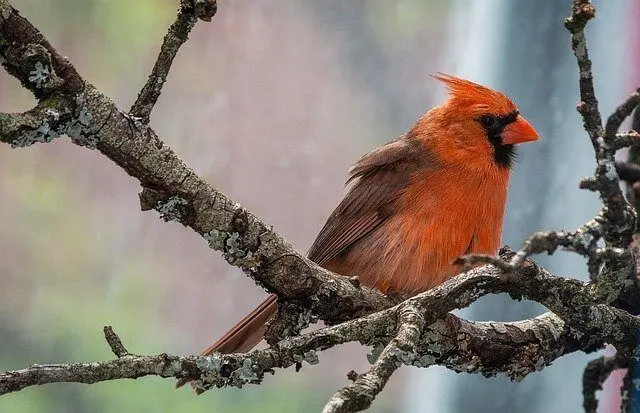
Virginia Bird and Wildlife Trails
Nature abounds in Virginia from the peaks of the Appalachian mountains in the southwest reaches of the state to the surf breaking on the sand of the Atlantic Ocean beaches almost six-hundred miles east. Did you know it would take ten hours (non-stop) to drive from Ewing, Virginia to Assateague Island National Seashore? The Virginia Department of Wildlife Resources has several dozen bird and wildlife trails categorized into three distinct regions: Coastal, Piedmont, and Mountain. While numerous species of birds, fish, mammals, and reptiles overlap, you’ll most certainly find those that are only specific to each location as well. The Seashore to Cypress loop makes stops through Chesapeake and Virginia Beach, visiting places such as Bay Bay National Wildlife Refuge, False Cape State Park, First Landing State Park, and the Norfolk Botanical Garden. If your feet are too tired to walk the more than ten miles of paths and trails at Norfolk Botanical Garden, you can ride the tram or take a boat tour! Popular Piedmont Region loops include the James River Loop, Monticello and Rivanna Loop, and Staunton River Loop. Looking for a place to spot wildlife that has picnic facilities, playgrounds, restrooms, river beach access, scenic overlooks, and trails? Pleasant Grove Park in Fluvanna County, just west of Palmyra, has all of that and more. It’s easy to spend the entire day at this almost 1,000 acre park, and it’s free for public use! The Mountain Region has the most loop trails and visits popular places such as Big Stone Gap, Mount Rogers, Peaks of Otter, and Skyline Drive. The Allegheny Highlands Loop, Appalachian Wonders Loop, Daughters of the Stars Loop, and Lost Shoe offer something off the beaten path. Looking for an incredibly elusive animal? Head out to Big Cedar Creek on the Saint Paul Loop and test your habit knowledge while trying to find the rare hellbender. Short and long hikes, small and large animals- you’ll find all of those and more on Virginia Bird and Wildlife Trails.
Virginia Blueways
Want a calm, serene, unique way to see some of the best natural beauty Virginia has to offer? Float it or paddle it! Take your canoe, kayak, raft, or tube and get on the water. If you don’t own one, there are several outfitters on the Clinch River, James River, New River, Rappahannock River, Rivanna River, Shenandoah River, and others that will drop you off at a designated put-in and pick you up at the take-out location. The Upper James River Water Trail begins in Clifton Forge and meanders down sixty miles of river. No need to be an expert paddler as most rapids are Class I-II, although there are a few Class III for those looking for something a little more challenging. The New River Water Trail is almost forty miles of designated water with several locations to put in or take out, leaving you options for shorter and longer trips. The Southern Virginia Wild Blueway contains segments of the Roanoke River, Dan River, and the Banister River. If you’re looking for more open water options, the Virginia Seaside Water Trail has you paddle the bays around Assateague and Chincoteague Islands and Great Machipongo River. A simple Google search will provide you with even more float and paddle opportunities.
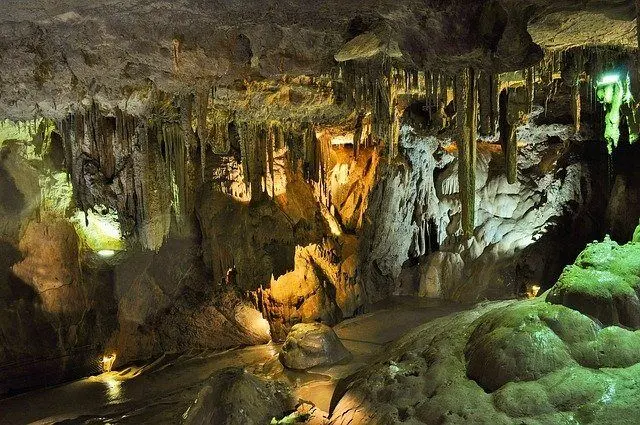
Virginia’s Caverns
Take it underground. On a sultry summer day or a wet and windy winter day, you may not want to brave the elements but you’re still itching to get out of the house. Virginia has over half a dozen caverns open to public touring. With a constant comfortable temperature, caverns are a great place to beat the heat in the summer and escape the chill of winter. Luray Caverns are the largest and most popular caverns in the state. Visitors can view multiple large chambers filled with stalagmites, stalactites, towers, reflecting lakes, and the world’s largest musical instrument- the Great Stalacpipe Organ. Also in the Shenandoah Valley you’ll find Endless Caverns, Grand Caverns, Natural Bridge Caverns, Shenandoah Caverns, and Skyline Caverns. Dixie Caverns near Roanoke and Gap Caverns in Cumberland Gap National Park round out the list.
Christmas Displays in Virginia
It’s hard not to get in the Spirit of Christmas when houses, city streets, and small-town businesses begin to put up bright lights and decorations. Across Virginia, there are so many great places to drive or walk through to view magnificent displays. Going on almost thirty years of operation, the Celebration in Lights at Newport News Park is Virginia’s longest-running drive-through light display. In approximately two miles, you’ll see over 350 static displays, fifty arches, and three miles of rope lighting. While you’re in the Historic Triangle and Hampton Roads area, take a drive on the Virginia Beach Boardwalk to see Holiday Lights at the Beach, the Dominion Garden of Lights at the Norfolk Botanical Garden, or walk through Christmas Town at Busch Gardens. In Northern Virginia, at Bull Run Regional Park, the Bull Run Festival of Lights is over two miles long and includes a Christmas Carnival and Holiday Village with children’s activities and shopping. In Richmond, the Dominion Energy Gardenfest of Lights at Lewis Ginter Botanical Garden features Christmas decorations, lights, activities and food.
Virginia Civil War Trails
Although debatable, Virginia is considered by most to be the preeminent location to learn, see, or study the Civil War. The first and last major battles of the Eastern theater of the war, along with countless other skirmishes and entire campaigns, were fought right here in Virginia. The grounds between Richmond and Washington, D.C. saw loss like no other. To the unfamiliar, a battlefield may seem just that, a field of tall grass in the middle of some unknown locale. To those who have been, there’s so much more to offer. Historical context reigns with signs, markers, monuments, and interpretive trails. Driving tours follow timelines of events with interspersed stops; some with elaborate, lengthy trails. Others have a simple plaque noting what took place. Campaigns you can follow include the Crossroads of Conflict 1861-1865, the Peninsula Campaign of 1862, Lee vs Grant 1864, Lee’s Retreat 1865, and more. Battlefields such as Brandy Station, Gaine’s Mill, Petersburg, Spotsylvania Courthouse, Sailor’s Creek, and The Wilderness offer days of endless exploration.
At Manassas National Battlefield Park, walk on the Stone Bridge over the gently flowing Bull Run, over a few hundred yards of wooden planks, up the hill to the footprint of the Van Pelt house, and be rewarded with a view over the eastern portion of the battlefield. Hike the entire 5.5 mile Spotsylvania History Trail over open land and streams, through forests, by several farm ruins, and try to grasp the ferocity of the fighting at Bloody Angle. Visit the rows of cannon at Malvern Hill. At Five Forks Recreational Trail System there are joint use trails for biking, hiking, and horseback riding with interpretive markers explaining the movements and significance of the fighting that took place. From the visitors center at Fredericksburg National Battlefield Park, walk the Sunken Road Walking Trail past part of the original stone wall that lined the road, which Confederates used for cover when firing down towards the Rappahannock River as Burnside’s Union Army of the Potomac crossed in wave after failed wave. Looking for something a little more challenging? Hike up the steep trail to the top of Sittlington’s Hill at McDowell Battlefield in western Virginia. If these aren’t enough, you don’t have to look very hard many more that may be closer to you, as there wasn’t hardly a county in Virginia whose land wasn’t touched by the Civil War.
The Crooked Road
If you’re a fan of bluegrass or country music, this is the driving trail for you. If you’re not, The Crooked Road is still a great drive for picturesque landscapes and interesting rural small-town stops. Twenty-five wayside exhibits through nineteen Virginia counties comprise the experience of the birth and tradition of American music. At each stop, look at the pictures, read the history, and tune in your radio to the corresponding FM station and listen to the recordings and a sampling of music. Along the way, major venues that hold large festivals, jam sessions, and nights of pickin’ are must-sees. One of the largest, Floydfest, brings in people from across the country for five full days of music. Bring your camper and pack some lawn chairs. Visit Big Walker Country Store or Floyd Country Store for evenings of a bygone era. For a full historical music experience covering centuries, check out the Blue Ridge Music Center just off The Blue Ridge Parkway at Milepost 213 near the town of Galax.
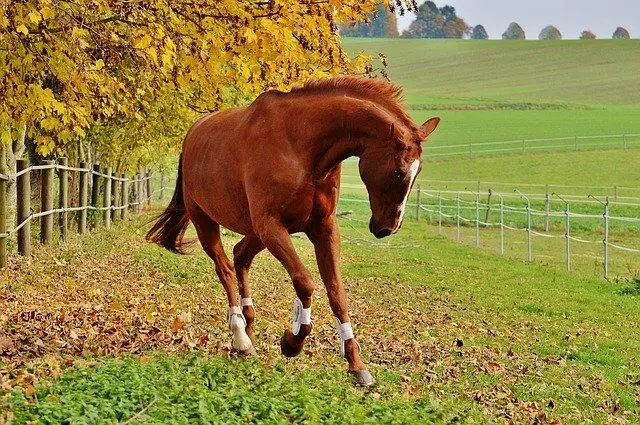
Horsing Around Virginia
Forests and parks in every region of Virginia have horse trails for every rider. There are fee and free-use trails that range from just a few miles to almost 250 miles and terrain varies just as much. Forests and balds in the mountains and meadows and water down low, Virginia’s horse trails have it all. Many even allow camping. James River State Park in Buckingham County has two equestrian campgrounds with stalls. Douthat State Park, Fairy Stone State Park, Grayson Highlands State Parkand Occoneechee State Park also all have campsites with stalls. Backcountry campsites are scattered throughout the George Washington and Jefferson National Forests. One popular method to tour the Gettysburg National Battlefield Park in Pennsylvania is by guided horseback tours. In Virginia, Bristow Station Battlefield Heritage Park, Five Forks Battlefield, Manassas Battlefield National Park, and Petersburg National Battlefield Park all have designated horse trails. If you’re looking for an adventure reminiscent of the days of early explorers through dense woodlands with primitive camping, head out to the Mount Rogers Ranger District where you’ll find 278 miles of trails. If it’s hot in the lowlands, head up to the Blue Ridge Mountains in Shenandoah National Park where it’s notably cooler. By contrast, if it’s cold in the mountains, take a ride in the southeastern portion of the state on the Dismal Swamp Canal Trail in Chesapeake or West Neck Creek Natural Area in Virginia Beach. Wherever you are in Virginia, you’re always near a great location to saddle up.
Motorcycle Madness
If you own a motorcycle, the central and western portions of Virginia are nothing short of a playground. Foothills, mountains, hairpin turns and sweeping curves are all that a biker could ask for. There’s the obvious iconic Blue Ridge Parkway and Skyline Drive, which most riders are well aware of, but in the southwest portion of Virginia, several notable loops and routes are gaining popularity. Appalachian Backroads has developed several rides with multiple points of interest, great places to eat, and of course, lots of curves. The Back of The Dragon runs from Hungry Mother State Park to Tazewell on Route 16. Thirty-two miles of blacktop hold 438 curves up and down several mountain ranges and ridgelines. Make sure you know yours and your bike’s capabilities so you don’t drag boards or pegs too much on Cliff Hanger, Frame Bender, and Zero Gravity Curves. Stop and take a break at Million Dollar View. Other mapped rides include Bootlegger, Heartbreaker, RoadRUNNER, and Skull Cracker, among others. On these roads you’ll pass through the towns of Big Stone Gap, Burkes Garden, Castlewood, Ewing, Gate City, and Grundy in the rural Heart of Appalachia.
Virginia’s Rail Trails
As old logging and other railroad lines had run their useful course, the cuts made to lay the track still existed. What could be done with them? The infrastructure was already in place, so make them into trails, of course! Virginia has several short and long rail trails that are perfect for long or short walks, hikes, or rides. The Blue Ridge Railway Track Trail in Nelson County, made from packed gravel, begins in Piney River and runs for 6.5 miles, ending at the Tye River Depot. The Chessie Nature Trail following the Maury River for seven miles from Lexington to Buena Vista is “A Rail-Trail for All Ages.” Guest River Gorge Trail, in extreme southwest Virginia just outside of Coeburn, follows the river through woodlands and 300-million year old rock formations. High Bridge State Park is on a portion of a 31 mile rail trail near Farmville. The namesake, a historic bridge constructed in 1853, is half a mile long, spanning the Appomattox River 160 feet above. The James River Heritage Trail is a wonderful mix of rural and urban settings as it wanders through wooded nature areas and downtown Lynchburg along it’s eight mile length. New River Trail State Park covers almost sixty miles of trail through Carroll, Grayson, Pulaski, and Wythe counties. Following one of the oldest rivers in the world, the New (ironic name, huh?), you’ll pass by points of historic interest (Shot Tower), several falls, over bridges, and through tunnels. There are even primitive camping sites,picnic shelters, and restroom facilities along the trail. The most well known rail trail in Virginia is probably the Virginia Creeper Trail. The trail runs 34 miles from the top of Whitetop Mountain to the town of Abington. Bike outfitters will transport you and your own bike, or rented bikes, to the top so you can enjoy the seventeen mile shallow downhill grade all the way into Damascus.
Tunnel Trails of Virginia
Weather made by man or Mother Nature, there’s not much that’s not neat about tunnels and you’ve got several to choose from in Virginia if you want to go exploring. The fruits of a culmination of years of fundraising, planning, and restoration efforts have finally paid off and the Claudius Crozet Blue Ridge Tunnel is set to open to the public soon. Connecting Augusta and Nelson counties at Rockfish Gap on Alton Mountain, the railroad tunnel took eight years to construct from 1850-1858. Over 4,000 feet in length, it was the longest railroad tunnel in the US when it was completed. Natural Tunnel State Park, in the heart of Appalachia, has been called the eighth wonder of the world. A natural limestone tunnel made over thousands of years, railroad companies saw its potential for use and so laid some track. While you’re down there, check out Bee Tunnel, which is listed as the shortest trail toss tunnel in the world. Take a stroll on the paved Blackwater Creek Trail in Lynchburg and walk through the 500 foot Hollins Mill Tunnel. On the New River Trail, ride or walk through tunnels. Just want to drive through one? Big Walker and East River Mountain Tunnels on I-77 near the Virginia/West Virginia border are both around one mile long. On the complete opposite side of the state in the Chesapeake Bay Bridge Tunnel. Along with two one-mike tunnels, it’s constructed of man-made islands and twelve miles of bridges. Don’t forget to stop at the pier and get a plate of fresh blackened flounder.
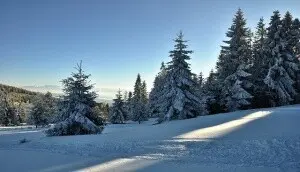
Winter Wonderland Trails of Virginia
While the options are somewhat limited compared to the Rockies, Virginia does have a few cross country skiing trails available. Just outside the “Capital” of the Appalachian Trail, Damascus, four trails: Cabin Creek Trail, Horse Trail (east), Old Upchurch Road, and Seed Orchard Road prodive almost ten miles of cross country skiing. Also, did you know that when the Blue Ridge Parkway and Skyline Drive are closed for winter weather conditions, cross country skiing is permitted on the closed sections? While you’re there, bring your snowshoes or winter boots for a unique experience hiking in the snow. With no leaves, the field of view allows you to see more you otherwise can’t, and with snow-covered ground, see how many animal tracks you can identify and you’ll be amazed at how many creatures are still very active in the winter. Looking for something a little faster and all downhill? Virginia has four ski resorts and one year-round artificial snow complex. Bryce Resort in Bayse has eight slopes and a tubing park. Massanutten Resort near Harrisonburg has fourteen slopes, a twelve lane tubing park, and a skating rink. The Omni Homestead has nine trails, a tubing park, an ice skating rink, and mini snowmobiles for young children. The largest, Wintergreen Resort near the top of The Blue Ridge Parkway in Nellysford, has twenty-four slopes and eight lane pubing park.
Virginia’s Wonderful Waterfalls
There are some amazing waterfalls scattered across the Blue Ridge mountains of Virginia. If you’re looking for a challenging hike to one, you’ll find it. If you’d rather do a drive by, well, you can do that too. Water cascading over cliffs, down chutes, and into pools is calming to the soul, soothing to the eyes, music to the ears, and you could spend days visiting them all. If you live near the mountains, you’re always only a short drive away from a waterfall. Even if you’re a city-dweller, you’re within a two hour drive, with the exception of those east of Richmond. One of the tallest waterfalls, Falling Spring Falls in the Alleghany Highlands, just outside of Covington, has a steady flow of water year round. It’s about a fifty yard walk from the parking lot to the viewing area and can even be seen from the road. Staton Creek Falls is a series of cascades in which several can also be seen from the road. If you’re interested in taking a hike to see waterfalls, White Oak Canyon in Shenandoah National Park has six different waterfalls, while Dark Hollow Falls is one of the most picturesque and popular waterfall hikes in the park. Don’t forget Doyles River Falls, Hazel Falls, Overall Run Falls, and South River Falls. Along and near the Blue Ridge Parkway, Apple Orchard Falls, Crabtree Falls, Saint Mary’s Waterfall, and White Rock Falls are popular hikes, though that list is not inclusive of all the waterfall hikes to choose from. A must see near Washington, D.C. is Great Falls National Park, where the Potomac River accelerates and crashes though the fall line before entering the tidal basin. Waterfalls with fairly easy hikes are Cascade Falls just outside Pearisburg, Less Falls in Natural Bridge State Park, Mine Bank Falls near Steeles Tavern, Roaring Falls near Eagle Rock, and Scotts Run waterfall in McLean.


















